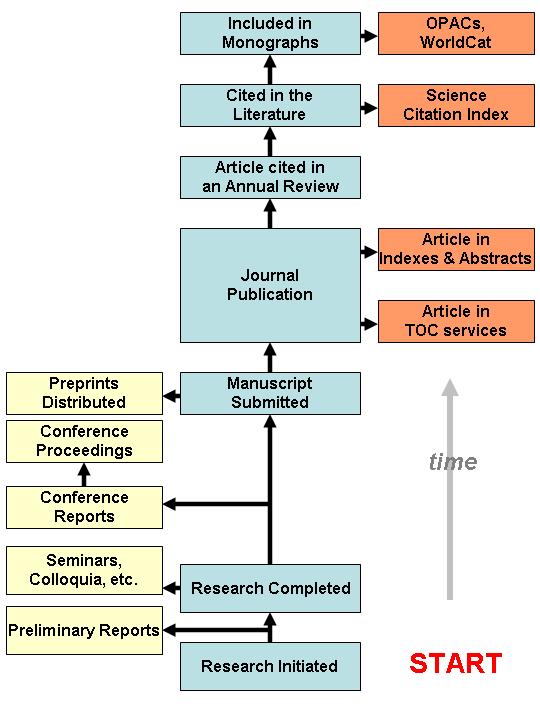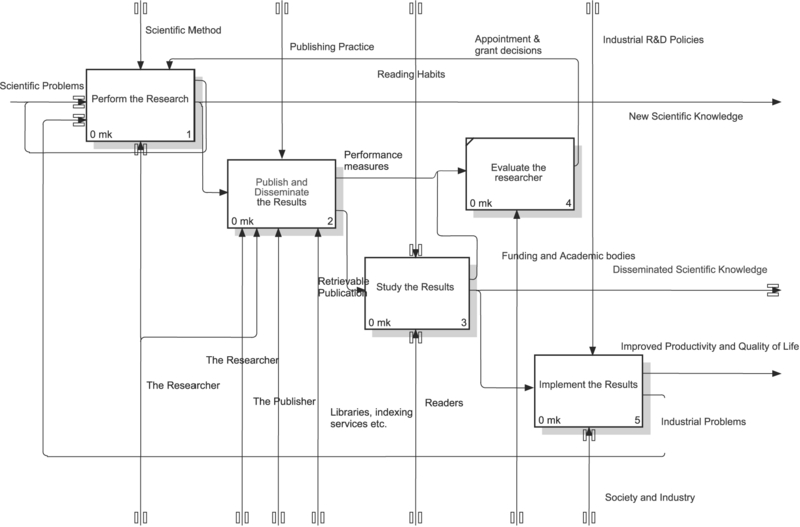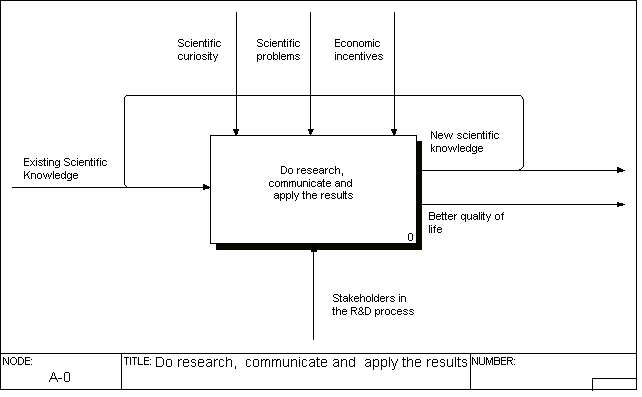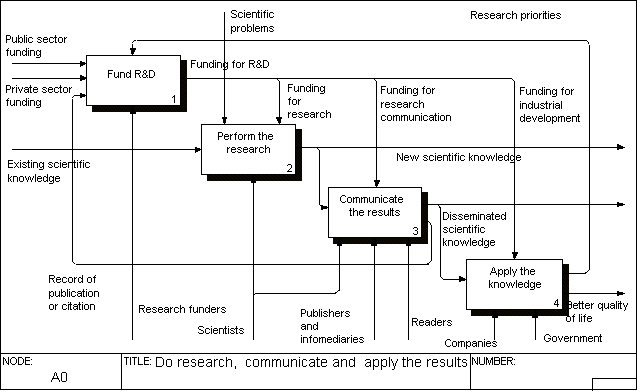Academic writing
 From EduTechWiki - Reading time: 6 min
From EduTechWiki - Reading time: 6 min
This piece will attempt to provide an overview of various issues related to academic writing.
The Björk process model of the scientific publishing life-cycle[edit | edit source]
According to Brörk and Hedlund (2004) and (2002), the stakeholders include:
- researchers who perform the research and write the publications;
- publishers who manage and carry out the actual publication process;
- academics who participate in the process as editors and reviewers;
- libraries that archive the publications and provide access to them;
- bibliographic services which facilitate the identification and retrieval of publications;
- readers who search for, retrieve and read publications; and
- practitioners who implement the research results directly or indirectly.
At a simple level analysis one could model the academic writing and publication process as a simple flow. e.g. Björk et al. (2003) present a synthesis of earlier models by Garvey and Griffith (1965) and Hurd (1996, 2004) with the following diagram:

According to Björk et al. (2003), one can model the do research, publish and implement the results life-cycle with the following IDEF0 diagram:

A revised more streamlined model was presented by Björk (2007) and can be summarized by two diagrams. The context diagram depicting the overall model “show how science as a global knowledge creating and sharing system can help improve everyday life as well as create new scientific knowledge, which is fed back into the existing body of scientific knowledge. The main participants in the process are collectively shown as a mechanism arrow coming into the activity box from below, and the main drivers controlling the behaviour of the participants are shown coming in from above (scientific curiosity, economic incentives). Also, scientific problems to be addressed by the research and the whole accessible body of existing scientific knowledge are seen as controls. From an academic viewpoint the main output is new scientific knowledge. From the viewpoint of society that funds research the most important outcome is better quality of life.”(Börk, 2007).

The life-cycle view in this model “is seen as consisting of four separate stages. Fund R&D is included in the model as a separate activity. One reason for this is the importance research funders (understood in the widest sense including basic university funding) have in the shaping of the scientific communication chain, since they, through research contracts and university guidelines, have a strong indirect influence on where researchers choose to publish their work. This can for instance be seen in the recent mandates and recommendations of the NIH, Wellcome Trust, Research Councils UK or Finland's Department of Education. Perform the research is the most resource demanding part of the system. Communicate the results is the most extensive part of the model. The end result of this activity is called disseminated scientific knowledge, reflecting the viewpoint that scientific results which have been published, but which are not read by the intended readers are rather useless. The downstream activity apply the Knowledge is important in order to achieve the improved quality of life which research funders mainly are looking for.” (Börk, 2007).

Teaching academic writing[edit | edit source]
“Although models have been a mainstay of academic writing pedagogy for centuries, a recurrent critique has been that they control or limit student writing and misrepresent the affairs they claim to model. These insufficiencies notwithstanding, models are ubiquitous in the ordinary, practical world, and their usefulness to novices can easily go unnoticed by experts.” (MacBeth, 2009:1).
“Model texts, skeletal or otherwise, do offer the promise that if one follows them an ideal outcome will result. Leki (1995) found in her case studies of university-level English language learners that looking for such models and examples was a common coping strategy used by the students to survive the writing demands of their disciplinary courses [...] The shortcoming of such models or sample texts may well be their strongest recommendation to novices. They offer formal, generic representations of social practices that are far from generic or formally structured. They convey these practices not only as formal and structured, but stable, reliable, and vividly so. Yet other tasks and occasions will defeat the model's assurances, as the students later discover. These “false provisions” have something to do with the familiar critique of models as a curricular design. The criticisms are longstanding and foreshorten our interest in and appreciation for the work models do. In light of the materials presented here, we can see how the model text achieved what a pedagogy for novices must achieve: it must be vivid, evident, stable, and show its “parts.” But it achieves this accessibility for novices through the false representation of the social practices and conventions it represents.” (MacBeth, 2009:13).
Digital tools for academic writing[edit | edit source]
Though many wriitng tools exist to give feedback on grammar and spelling or to detect plagiarism digital tools for academic writing exist mainly in four categories:
- Automated essay scoring tools providing summative feedback only mostly based on proprietary algorithms
- Automated writing evaluation tools using corpus analysis, natural language processing (NLP) or latent semantic analysis (LSA)
- Interactive writing platforms combining prompts, pedagogical scaffolding, or self-regulated strategy learning guidance, with or without corpus analysis, NLP or LSA.
- Intelligent tutoring systems that can include all of the above but are mainly focused on individualized strategy learning writing guidance
Strobl et al.(2018) [1] presented a review of 88 digital tools for academic writing with a fine-grained review of 44 tools proviing a framework for analysing academic writing tools according to their general target specifications, instructional approaches (task, prescribed setting, targeted skills, interaction support), technical specifications, feedback modalities.
Some academic writing tools[edit | edit source]
- ThesisWriter: developed at the Zurich University of Applied Science (ZHAW), German and English
- AcaWriter - demo version) + open source release: learning analytics feedback on writing, developed by the University of Technology Sydney’s Connected Intelligence Centre,
Links[edit | edit source]
- The Scientific Communication Life-Cycle model
- Author and reviewer tutorials by Springer publishers (2017).
References[edit | edit source]
- ↑ Strobl, C., Ailhaud, E., Benetos, K., Devitt, A., Kruse, O., Proske, A., & Rapp, C. (2018). Digital support for academic writing: A review of technologies and pedagogies. Computers & Education, 131(September 2018), 33–48.
Bibliography[edit | edit source]
- Belcher, D. and A. Hirvela, (1995). (Eds) Academic writing in a second language: Essays on research and pedagogy, Ablex, Norwood, NJ.
- Brodkey, L. (1987) Academic writing as social practice, Temple University Press, Philadelphia (1987).
- Björk, Bo-Christer and Turid Hedlund, (2004). A formalised model of the scientific publication process, Online Information Review, 28 (1). PDF - Abstract/HTML/PDF.
- Björk, Bo-Christer; Turid Hedlund, Jonas Holmström, and John Cox, (2003). D2: Scientific Publishing: To-Be Business and Information Model, SciX (Open, self organising repository for scientific information exchange) PDF, retrieved 14:20, 22 October 2009 (UTC).
- Björk, B-C. (2007). "A model of scientific communication as a global distributed information system" Information Research, 12(2) paper 307. [Available at http://InformationR.net/ir/12-2/paper307.html], retrieved 14:20, 22 October 2009 (UTC).
- Macbeth, Karen P. (2009). Deliberate false provisions: The use and usefulness of models in learning academic writing, Journal of Second Language Writing, In Press, Corrected Proof, Available online 15 October 2009, ISSN 1060-3743, DOI: 10.1016/j.jslw.2009.08.002
- Hyland, K. (2004) Disciplinary discourses: Social interactions in academic writing, University of Michigan Press, Ann Arbor (2004).
- Leki, I. (2007) Undergraduates in a second language: Challenges and complexities of academic literacy development, Erlbaum, Mahwah, NJ (2007).
- Dores, Robert M. ; Ian W. Henderson, Autoplagiarism, citation rating, and skulduggery, General and Comparative Endocrinology, Volume 140, Issue 2, 15 January 2005, Page 85, ISSN 0016-6480, DOI:10.1016/j.ygcen.2004.12.001
- Lewison, G. (2006). Beyond SCI citations: new ways to evaluate research. Current Science, Special Section: 50 Years Of Citation Indexing 89(9), 1524-1530. PDF
- Macbeth, K. (2006). Diverse, unforeseen, and quaint difficulties: The sensible responses of novices learning to follow instructions in academic writing, Research in the Teaching of English 41 (2006), pp. 180–197.
- Leydesdorff, Loet (2005). Evaluation of research and evolution of science indicators, Current Science, Special Section: 50 Years Of Citation Indexing 89(9), 1524-1530. PDF
- Persson, Olle (2005). Citation Indexes for Science - A 50 year citation history, Current Science, Special Section: 50 Years Of Citation Indexing 89(9), 1524-1530. PDF
- Shih, M. (1986). Content-based approaches to teaching academic writing, TESOL Quarterly 20 (1986), pp. 617–648. PDF
- Swales, J. and C. Feak, (2004). Academic writing for graduate students: Essential tasks and skills (2nd Ed.), University of Michigan Press, Ann Arbor (2004).
Move to Open contents[edit | edit source]
- Björk, B.-C. (2003), "Towards open access to scientific publications – which are the barriers to change", paper presented at the DigiLib2003 Conference: Towards a User-Centred Approach to Digital Libraries, National Library of Finland, Espoo, September
- Odlyzko, A. (1998), "The economics of electronic journals", Journal of Electronic Publishing, http://www.press.umich.edu/jep/04-01/odlyzko.html, Vol. 4 No.1, .
- Gueédon, J.C. (2001), ``In Oldenburg's long shadow: librarians, research scientists, publishers, and the control of scientific publishing, ARL Proceedings 138, Association of Research Libraries, Washington DC, http://www.arl.org/resources/pubs/mmproceedings/
 KSF
KSF